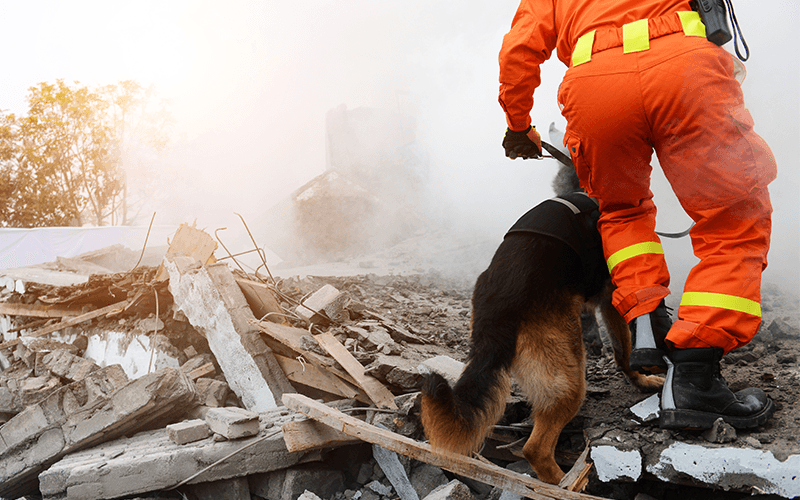If you are the property manager of a multi-unit residential building, you have no doubt developed a plan for emergency or disaster situations. Fires, flooding, storms, tornados, and hurricanes can wreak havoc on a multi-unit residential complex. The chaos that immediately follows can cause a ripple effect on survival and business continuity.
For example, the statistics on apartment or multi-unit residential building fires are daunting. According to the National Fire Protection Association (NFPA), there were approximately 95,000 apartment fires in 2016 that resulted in more than 325 deaths and more than $711 thousand in property loss or damages (not including business interruption costs).
In addition to the police, firefighters, and emergency medical personnel, a restoration company is among the first responders to the disaster site. Restoration crews have witnessed scenes of utter chaos as well as relative calm – the difference being that the property management company had at least a rudimentary disaster plan in place.
Several steps in building a business continuity plan are adaptable to the multi-family business climate:
- Project Initiation and Management
- Risk Evaluation and Control
- Developing Preventative and Mitigation Strategies
- Emergency Response and Operations
- PR and Crisis Communications
- Coordination with Public Authorities
- Staff and Resident Awareness and Training
Life safety is, of course, paramount and a huge topic unto itself. For now, let’s focus on managing the chaos at the scene so that property recovery can begin without delay.
At the time of an incident, the Fire department and the restoration company will immediately need a number of things from the property management company:
- Designated, responsible party from your company to act as a liaison with them for the duration of the event
- List of residents (to account for everyone)
- List of residents with special needs
- Building plans to locate main utility connections
- Master key locations
It is suggested that this essential information be included in an on-call manager packet that would also include
- Copy of the Emergency Response Manual
- A blaze orange vest and hat for immediate identification in an emergency
- Call out (or fan out) list for notification of additional staff members
- Key vendor contact list
Security Issues
One of the biggest determining factors in the chaos quotient is crowd control. Disaster scenes often attract large crowds milling around and unidentified individuals roaming freely into damaged buildings and removing contents from units. At best, this is a security breach. At worst, a liability issue.
Residents’ expectation of immediate access to their units has to be balanced with life safety issues and the property manager’s responsibility to maintain security and control. Hazardous byproducts from combustion such as carbon monoxide may be present and the structural integrity of the building may be in question.
Significant control can be realized by establishing a holding area, preferably with phones, where residents and others can congregate. Only after the impacted building has been declared safe by the building authorities should residents be permitted to re-enter. Then, disturbance of damaged sites should be limited to essential items and irreplaceable personal property. Residents should be instructed to contact their respective insurance companies for further instructions when applicable.
While fire departments or city business departments often provide area security, property managers should be prepared to take responsibility for perimeter security if needed. Restoration service providers are equipped to set up a fence perimeter, board-up exposed areas and get locks on all unit doors as quickly as possible. Emergency responders also have emergency security firms, plumbers, electricians and other emergency service providers available to call in as necessary.
Drop-In Visitors
Uninvited but interested parties may try and gain access to your property immediately after a disaster. The media, competing restoration companies and public adjusters are among uninvited visitors who may make an appearance.
- Limit the media’s access to the scene and make sure you have a designated information representative available to meet with them.
- Pre-identify a restoration service provider in your contingency plan. This crucial decision should not be made in the midst of crisis. This is arguably the single most critical decision in getting your property back to normalcy quickly. Besides, you should already have a provider at the scene helping you with security issues and damage mitigation.
- Public adjusters may seek contractual agreements to represent the property owners as agents in negotiating claim settlements with insurance companies. They may also approach your insured residents to provide this service regarding their personal belongings. Public adjusters are paid by the insured, not by the insurance company, and their fees are often a percentage of the settlement.
Insurance and Your Residents
You may already educate potential residents to the value of carrying their own insurance. Still, statistics show that multi-family residents across all income levels are less likely to carry their own insurance. Many residents believe the property owner’s insurance will cover their losses. Consider distribution of the American Red Cross publication “Could You Afford To Lose Everything?” that paints a vivid picture of the dire straits faced by the uninsured after a property loss.
The first 24 to 48 hours after an incident are the most crucial and disappear quickly if unprepared. Having a disaster plan in place will minimize property loss, limit liability and reduce recovery time. Plus, you will retain the confidence and loyalty of your residents.




 CAI - Illinois Chapter
CAI - Illinois Chapter 



